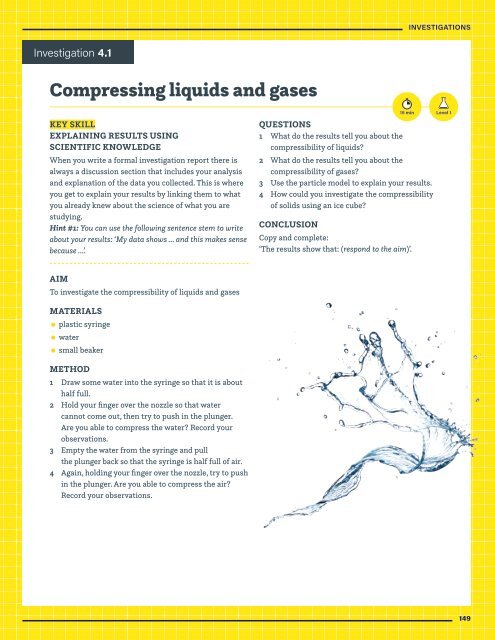Good Science Victorian Curriculum Year 7
Digital sample of Matilda's newest publication, Good Science Victorian Curriculum Year, authored by Emma Craven and Aaron Elias. For more information visit www.matildaeducation.com.au or email Katrina Tucker, katrinatucker@matildaed.com.au
Digital sample of Matilda's newest publication, Good Science Victorian Curriculum Year, authored by Emma Craven and Aaron Elias. For more information visit www.matildaeducation.com.au or email Katrina Tucker, katrinatucker@matildaed.com.au
Create successful ePaper yourself
Turn your PDF publications into a flip-book with our unique Google optimized e-Paper software.
INVESTIGATIONS<br />
Investigation 4.1<br />
Compressing liquids and gases<br />
KEY SKILL<br />
EXPLAINING RESULTS USING<br />
SCIENTIFIC KNOWLEDGE<br />
When you write a formal investigation report there is<br />
always a discussion section that includes your analysis<br />
and explanation of the data you collected. This is where<br />
you get to explain your results by linking them to what<br />
you already knew about the science of what you are<br />
studying.<br />
Hint #1: You can use the following sentence stem to write<br />
about your results: ‘My data shows … and this makes sense<br />
because …’.<br />
15 min<br />
QUESTIONS<br />
1 What do the results tell you about the<br />
compressibility of liquids?<br />
2 What do the results tell you about the<br />
compressibility of gases?<br />
3 Use the particle model to explain your results.<br />
4 How could you investigate the compressibility<br />
of solids using an ice cube?<br />
CONCLUSION<br />
Copy and complete:<br />
‘The results show that: (respond to the aim)’.<br />
Level 1<br />
AIM<br />
To investigate the compressibility of liquids and gases<br />
MATERIALS<br />
• plastic syringe<br />
• water<br />
• small beaker<br />
METHOD<br />
1 Draw some water into the syringe so that it is about<br />
half full.<br />
2 Hold your finger over the nozzle so that water<br />
cannot come out, then try to push in the plunger.<br />
Are you able to compress the water? Record your<br />
observations.<br />
3 Empty the water from the syringe and pull<br />
the plunger back so that the syringe is half full of air.<br />
4 Again, holding your finger over the nozzle, try to push<br />
in the plunger. Are you able to compress the air?<br />
Record your observations.<br />
149


















